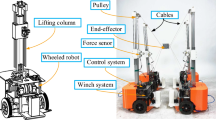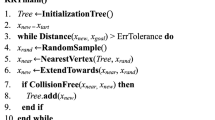Abstract
Cable-driven parallel robots (CDPRs) have demonstrated a remarkable potential for a wide range of applications over the past few decades. However, multiple cables introduce various interferences, which is a challenging task for the path planning of CDPRs. In this study, an adaptively optimal rapidly exploring random tree (RRT*) is proposed for CDPRs to generate collision-free paths in cluttered environments. The proposed method considers the kinematic performance of CDPRs by maximizing the feasible wrench volume and optimizing the dexterity of the robot. Furthermore, a sampling method was developed to guide the tree growth efficiently, by adaptively adjusting the sampling space. In the sampling space, the adaptive forward and backward areas are defined for biased sampling, and the probability weight of both areas is determined by the failure rate of the current node expansion. Finally, a post-processing method was adopted to obtain a shorter and smoother path. Simulations and experiments were carried out to verify the proposed path planning method on a self-built 8–6 (8 cables with 6 degrees of freedom) CDPR. The results indicate that the proposed method has much better efficiency than the conventional RRT* method, and the kinematic performance of the CDPR can be guaranteed.












Similar content being viewed by others
References
Abdolshah S, Zanotto D, Rosati G, Agrawal SK (2017) Optimizing stiffness and dexterity of planar adaptive cable-driven parallel robots. J Mech Robot 9(3):031004
Bak JH, Hwang SW, Yoon J, Park JH, Park JO (2019) Collision-free path planning of cable-driven parallel robots in cluttered environments. Intel Serv Robot 12(3):243–253
Bouchard S, Gosselin C, Moore B (2010) On the ability of a cable-driven robot to generate a prescribed set of wrenches
Bury D, Izard JB, Gouttefarde M, Lamiraux F (2019) Continuous collision detection for a robotic arm mounted on a cable-driven parallel robot. In: 2019 IEEE/RSJ international conference on intelligent robots and systems (IROS). IEEE, pp 8097–8102
Duan Q, Vashista V, Agrawal SK (2015) Effect on wrench-feasible workspace of cable-driven parallel robots by adding springs. Mech Mach Theory 86:201–210
Fukuda K (2004) From the zonotope construction to the Minkowski addition of convex polytopes. J Symb Comput 38(4):1261–1272
Gagliardini L, Caro S, Gouttefarde M, Wenger P, Girin A (2014) Optimal design of cable-driven parallel robots for large industrial structures. In: 2014 IEEE international conference on robotics and automation (ICRA). IEEE, pp 5744–5749
Gosselin C (2014) Cable-driven parallel mechanisms: state of the art and perspectives. Mech Eng Rev 1(1):DSM0004
Idà E, Bruckmann T, Carricato M (2019) Rest-to-rest trajectory planning for underactuated cable-driven parallel robots. IEEE Trans Rob 35(6):1338–1351
Idá E, Briot S, Carricato M (2021) Natural oscillations of underactuated cable-driven parallel robots. IEEE Access 9:71660–71672
Jiang X, Barnett E, Gosselin C (2018) Dynamic point-to-point trajectory planning beyond the static workspace for six-dof cable-suspended parallel robots. IEEE Trans Rob 34(3):781–793
Karaman S, Frazzoli E (2011) Sampling-based algorithms for optimal motion planning. Int J Robot Res 30(7):846–894
Lahouar S, Ottaviano E, Zeghoul S, Romdhane L, Ceccarelli M (2009) Collision free path-planning for cable-driven parallel robots. Robot Auton Syst 57(11):1083–1093
LaValle SM (1998) Rapidly-exploring random trees: a new tool for path planning
Mishra UA, Mishra U, Métillon M, Caro S (2021) Kinematic stability based AFG-RRT* path planning for cable-driven parallel robots. In: The 2021 IEEE international conference on robotics and automation (ICRA 2021).
Nguyen DQ, Gouttefarde M (2015) On the improvement of cable collision detection algorithms. Cable-Driven Parallel Robots. Springer, Cham, pp 29–40
Olson E (2011) AprilTag: a robust and flexible visual fiducial system. In: 2011 IEEE international conference on robotics and automation. IEEE, pp 3400–3407
Ong CJ, Gilbert EG (1997) The Gilbert-Johnson-Keerthi distance algorithm: a fast version for incremental motions. In Proceedings of international conference on robotics and automation, vol 2. IEEE, pp 1183–1189
Qian S, Zi B, Shang WW, Xu QS (2018) A review on cable-driven parallel robots. Chin J Mech Eng 31(1):1–11
Rasheed T, Long P, Roos AS, Caro S (2019) Optimization based trajectory planning of mobile cable-driven parallel robots. In: 2019 IEEE/RSJ international conference on intelligent robots and systems (IROS). IEEE, pp 6788–6793
Rasheed T, Long P, Caro S (2020) Wrench-feasible workspace of mobile cable-driven parallel robots. J Mech Robot 12(3)
Wischnitzer Y, Shvalb N, Shoham M (2008) Wire-driven parallel robot: permitting collisions between wires. Int J Robot Res 27(9):1007–1026
Xu J, Park KS (2020) A real-time path planning algorithm for cable-driven parallel robots in dynamic environment based on artificial potential guided RRT. Microsyst Technol 26(11):3533–3546
Yershova A, Jaillet L, Siméon T, LaValle SM (2005) Dynamic-domain RRTs: efficient exploration by controlling the sampling domain. In: Proceedings of the 2005 IEEE international conference on robotics and automation. IEEE, pp 3856–3861
Yuan H, Courteille E, Deblaise D (2015) Static and dynamic stiffness analyses of cable-driven parallel robots with non-negligible cable mass and elasticity. Mech Mach Theory 85:64–81
Zhang B, Shang W, Cong S (2018) Optimal RRT* planning and synchronous control of cable-driven parallel robots. In: 2018 3rd international conference on advanced robotics and mechatronics (ICARM). IEEE, pp 95–100
Acknowledgements
This study was supported by the National Research Foundation of Korea (NRF) grant funded by the Korea government (MSIT) (2021R1A2C2013053) and Ministry of Trade, Industry and Energy (MOTIE) and the Korea Energy Technology Evaluation Institute (KETEP) (20194030202440).
Author information
Authors and Affiliations
Corresponding author
Additional information
Publisher's Note
Springer Nature remains neutral with regard to jurisdictional claims in published maps and institutional affiliations.
Rights and permissions
About this article
Cite this article
Xu, J., Park, KS. Kinematic performance-based path planning for cable-driven parallel robots using modified adaptive RRT*. Microsyst Technol 28, 2325–2336 (2022). https://doi.org/10.1007/s00542-022-05319-3
Received:
Accepted:
Published:
Issue Date:
DOI: https://doi.org/10.1007/s00542-022-05319-3




